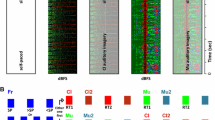Abstract
It has not been clear whether or not early information processing in the human auditory cortex is altered by voluntary movements. We report a movementrelated, complex event-related potential consisting of relatively long-lasting amplitude and phase perturbations induced in an ongoing auditory steady-state response (SSR) by brief self-paced finger movements. Our results suggest that processing in the auditory cortex during the first 50–100 ms after stimulus delivery is affected before, during, and after voluntary movements, beginning with a 1- to 2-ms delay in the SSR wave form starting 1–2 s before the movement.
Similar content being viewed by others
References
Berg P (1986) The residual after correcting event-related potentials for blink artifacts (abstract). Psychophysiology 23:354
Deecke L, Scheid P, Kornhuber HH (1969) Distribution of readi- ness potential, pre-motion positivity, and motor potential of the human cerebral cortex preceding voluntary finger movements. Exp Brain Res 7:158–168
Di S, Brett B, Barth DS (1994) Polysensory evoked potentials in rat parietotemporal cortex: combined auditory and somatosensory responses. Brain Res 642:267–280
Eckhorn R, Bauer R, Jordan W, Brosch M, Kruse W, Munk M, Reitboeck HJ (1988) Coherent oscillations: a mechanism of feature linking in the visual cortex? Multiple electrode and correlation analyses in the cat. Biol Cybern 60:121–130
Galambos R, Makeig S (1987) Dynamic changes in steady-state responses. In: Basar E (ed) Dynamics of sensory and cognitive processing of the brain. Springer, Berlin Heidelberg New York, pp 178–199
Galambos R, Makeig S, Talmachoff P (1981) A 40-Hz auditory potential from the human scalp. Proc Natl Acad Sci USA 78:2643–2647
Hars B, Maho C, Edeline J-M, Hennevin E (1993) Basal forebrain stimulation facilitates tone-evoked responses in the auditory cortex of awake rat. Neuroscience 56:61–74
Hazemann P, Auden G, Lille F (1975) Effect of voluntary selfpaced movements upon auditory and somatosensory evoked potentials in man. Electroencephalogr Clin Neurophysiol 39: 247–254
Hoormann J, Falkenstein M, Hohnsbein J (1994) Effect of selective attention on the latency of human frequency-following potentials. Neuroreport 5:1609–1612
Ikeda A, Shibasaki H, Nagamine T, Terada K, Kaju R, Fukuyama H, Kimura J (1994) Dissociation between contingent negative variation and Bereitschaftspotential in a patient with cerebellar efferent lesion. Electroencephalogr Clin Neurophysiol 9:359–364
Kristeva-Feige R, Feige B, Elbert T, Makeig S (1993) Oscillatory brain activity during a motor task. Neuroreport 4:1291–1294
Linden RD, Picton TW, Hamel G, Campbell KP (1987) Human auditory steady-state evoked potentials during selective attention. Electroencephalogr Clin Neurophysiol 66:45–59
McGee T, Kraus N, Littman T, Nicol T (1992) Contributions of the medial geniculate body subdivisions to the middle latency response. Hear Res 61:147–154
Makeig S (1990) A dramatic increase in the auditory middle latency response at very low rates. In: Brunia C, Gaillard A, Kok A (eds) Psychophysiological brain research. Tilburg University Press, Tilburg, pp 56–60
Makeig S (1993) Auditory event-related dynamics of the EEG spectrum and effects of exposure to tones. Electroencephalogr Clin Neurophysiol 86:283–293
Makeig S, Galambos R (1989) The CERP: event-related perturbations in auditory steady-state responses. In: Basar E, Bullock TH (eds) Brain dynamics: progress and perspectives. Elsevier, Amsterdam, pp 375–400
Makeig S, Elbert T, Braun C (1995) Magnetic event-related spectral perturbations. In: Deecke L (ed) Proceedings of the Ninth International Conference on Biomagnetism. IOS, Amsterdam, pp 135–146
Müller M, Rockstroh B, Berg P, Wagner M, Elbert T, Makeig S (1994) SSR modulation during slow cortical potentials. In: Pantev C et al. (eds) Oscillatory event-related brain dynamics. Elsevier, New York, pp 325–342
Pantev C, Makeig S, Hoke M, Galambos R, Hampson S, Gallen C (1991) Human auditory evoked gamma band magnetic fields. Proc Natl Acad Sci USA 88:8996–9000
Pantev C, Elbert T, Makeig S, Hampson S, Hoke M (1993) Relationship of transient and steady-state auditory evoked fields. Electroencephalogr Clin Neurophysiol 88:389–396
Pfurtscheller G, Araniber A (1979) Evaluation of event-related desynchronization (ERD) preceding and following voluntary self-paced movement. Electroencephalogr Clin Neurophysiol 46:793–800
Pfurtscheller G, Neuper C, Kalcher J, (1993) 40-Hz oscillations during motor behavior in man. Neurosci Lett 164:179–182
Rajkowski J, Kowak P, Aston-Jones G (1994) Locus coeruleus activity in monkey: phasic and tonic changes are associated with altered vigilance. Brain Res Bull 35:607–616
Ribary U, Ionnides AA, Singh KD, Hassan R, Bolton JP, Lado F, Mogliner A, Llinas R (1991) Magnetic field tomography of coherent thalamo-cortical 40-Hz oscillations in humans. Proc Natl Acad Sci USA 788:1037–1041
Rockstroh B, Müller M, Wagner M, Cohen R, Elbert T (1993) Event-related and motor responses to probes in a forewarned reaction time task in schizophrenic patients. Electroencephalogr Clin Neurophysiol 87:335–341
Rohrbaugh JW, Varner JL, Paige SR, Eckhardt MJ and Ellinger RJ (1990) Auditory and visual evoked pertubations in the 40 Hz auditory steady state response. Electroencephalogr Clin Neurophysiol 76:148–164
Romani GL, Williamson SJ, Kaufman L (1982) Tonotopic organization of the human auditory cortex. Science 216:339–340
Stapells DR, Makeig S, Galambos R (1987) Auditory steady-state responses: threshold prediction using phase coherence. Electroencephalogr Clin Neurophysiol 67:260–270
Szczepaniak WS, Møller AR (1983) Interaction between auditory and somatosensory systems: a study of evoked potentials in the inferior colliculus. Electroencephalogr Clin Neurophysiol 88:508–515
Tapia MC, Cohen LG, Starr A (1987) Attenuation of auditoryevoked potentials during voluntary movement in man. Audiology 26:369–370
Tiihonen J, Kajola M, Hari R (1989) Magnetic mu rhythm in man. Neuroscience 32:793–800
Woldorff MG, Hillyard SA (1991) Modulation of early auditory processing during selective listening to rapidly presented tones. Electroencephalogr Clin Neurophysiol 79:70–91
Author information
Authors and Affiliations
Additional information
This research was supported in part by the Department of the Navy, Naval Medical Research and Development Command, Bethesda, Maryland under work unit ONR.WR.30020(6429). The views expressed in this article are those of the authors and do not reflect the official policy or position of the Department of the Navy, Department of Defense, or the U.S. Government. Approved for release, distribution unlimited.
Rights and permissions
About this article
Cite this article
Makeig, S., Müller, M.M. & Rockstroh, B. Effects of voluntary movements on early auditory brain responses. Exp Brain Res 110, 487–492 (1996). https://doi.org/10.1007/BF00229149
Received:
Accepted:
Issue Date:
DOI: https://doi.org/10.1007/BF00229149




